The Google Nexus 6P Review
by Andrei Frumusanu on December 16, 2015 8:00 AM ESTBattery Life
Battery life on the Nexus 6P will be a quite interesting story. On one hand we have a very large 3450mAh battery, but on the other hand we have an AMOLED screen that is less efficient than most LCDs, all of which is driven by the Snapdragon 810, which trails in efficiency. Due to the Note 5 and Mi Note Pro both sharing the same form-factor and a 5.7” 1440p screen, they present perfect comparison devices that isolate either the screen advantage or disadvantage (Mi Note Pro) or the SoC differences between the devices (Note 5).
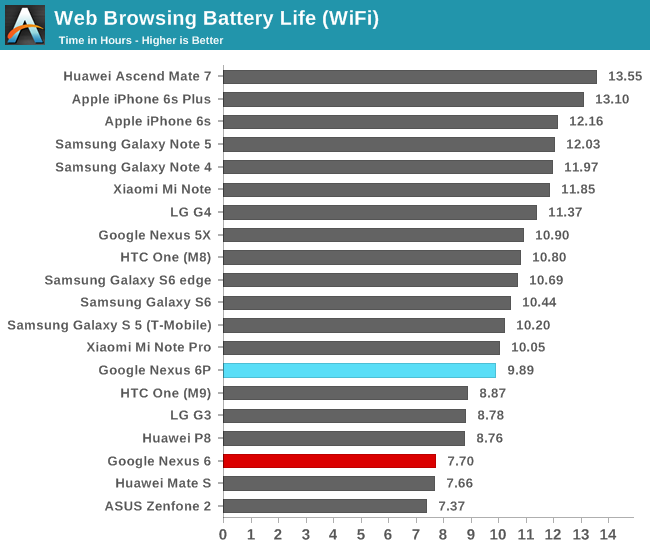
We start with our web-browsing battery test. Here we see the Nexus 6P reach 9.9h of runtime. While by itself this doesn’t represent a very bad figure and most people would be able to make do with such a number, when comparing it to other devices it represents a quite disappointing performance as the increased battery size doesn’t seem to give the 6P any advantage. The 6P reaches same battery figure as the Mi Note Pro which sports a smaller 3090mAh battery (11% disadvantage). As both devices sport the same SoC, any difference in the web browsing test is most likely due the power efficiency disadvantage of the AMOLED screen on the part of the 6P.
On the other hand if we want to look at the difference in efficiency of SoC, we can use the Note 4 as a relatively fair comparison. The Nexus 6P sports a screen that is ~5% more efficient and has a 7% advantage in battery capacity, yet it manages to fall behind the Note 4 with Snapdragon 805 by 16%, or almost 2 full hours.
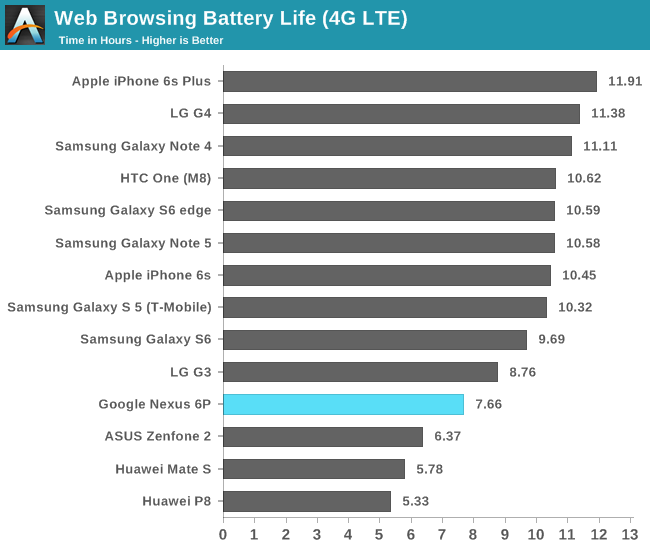
On the 4G LTE test, as with other reviews in the past I have to warn that I have worse cell network signal conditions compared to our other mobile reviewers Joshua Ho and Brandon Chester, making this not a fully accurate apples-to-apples comparison in terms of testing conditions. Keeping that in mind, we see the Nexus 6P also struggle to compete with the other devices in our results database.

PCMark’s battery life test is a more balanced workload that compromises of more real-world use-cases. Due to the test also having a lower average picture level (darker contents), the AMOLED screen is able to regain competitiveness against the Mi Note Pro. Again, mostly due to the efficiency disadvantage of the SoC, the differences between the Nexus 6P and the Note 5 remain large in this test as the former manages to last almost 1.5h longer even though the 6P has a 15% larger battery. Disregarding the competition, the 6P still manages to show some good battery scores in this test, although we do have some concerns over the performance demonstrated in the writing-subtest.

BaseMark OS II’s battery test is a very heavy CPU test that if more of a sustained performance and overall device TDP benchmark. Here the Nexus 6P lasts a little over 4 hours. As we’ve seen in the device thermals section from earlier, there’s a significant difference in long-term performance between devices even if they sport the same SoC.
How long a device can last in such a heavy load test is thus mostly a function of the thermal settings of the device, which does not give any good indication of the overall efficiency of the device. For example a given device can end up with a low battery runtime, but may have actually have better efficiency than one with higher battery runtimes. This rule is generally limited to synthetic scenarios as real-world scenarios where a device is thermally limited are generally rare.
Again for this review I feel I need to go a tangent to better explain why the Nexus 6P ends up with the battery life it has. The Snapdragon 810 and 808 unfortunately suffer from exceptionally bad efficiency that affects most of this year’s devices, Nexus 6P included. As we can see in the above graph, both SoCs exhibit worse performance/W efficiency than last year’s Snapdragon 800 series (805 included). For the Nexus 6P this is especially worrying as it would mean the device is actually less efficient than the Nexus 6 when it comes to computational loads. Unfortunately it seems that this year Samsung is alone in being able to showcase an improvement over last year’s devices courtesy of the Exynos 7420 enjoying a 2-3x lead in power efficiency over this year's competing high-end SoCs.
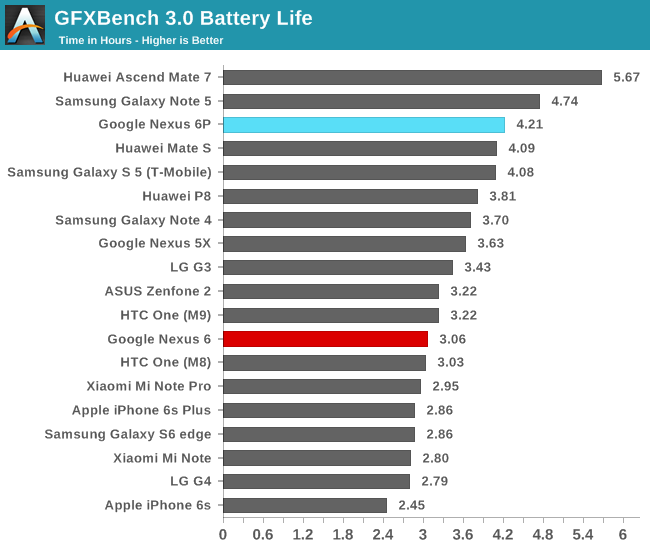
Lastly on GFXBench, the Nexus 6P ends up with 4.2 hours runtime on the on-screen battery test. This is a good result for the phone, even though it’s required to throttle to about 50% of its peak performance for most of the duration of the test to maintain reasonable skin temperatures. Here Qualcomm still has a considerable advantage over ARM’s Mali GPUs so that the Adreno 430 still is very competitive even though it has to deal with a process node disadvantage. It will be definitely be interesting to see how the Snapdragon 820’s Adreno 530 will be able to shake up the field.
Overall, the Nexus 6P offers what one would subjectively call good battery life. The large battery largely makes up for any SoC inefficiencies and we’ve even seen that the AMOLED display is near being on par with LCD’s power efficiency. If I seem a bit harsh it’s because I cannot shake the feeling that had the Nexus 6P come out with either the Snapdragon 805 or 820 we’d have seen much better battery figures more in line with the Note 5.
Charge Time
The Nexus 6P ships with a 3A@5V charger. The charger uses a USB Type-C connector, so you need a Type-C to Type-C cable to be able to charge the device. The Nexus 6P does ship with one out of the box, but I question Google’s decision as it would have been much more practical to receive a more traditional USB A to USB C cable to allow the Nexus 6P to charge from existing sources without having to buy an additional cable (technically the 6P does also come with such a cable, but at only about 15cm in length it’s very impractical).
The Nexus 6P along with the 5X are some of the first devices to come with USB Power Delivery 2.0, the official specification for device charging as opposed to more proprietary charger communication protocols such as those from Qualcomm (Quickcharge) or Adaptive Fast Charging that is used in Samsung chargers.
What seems to be interesting about the charging behaviour is that there’s visibly more charging “steps” than other devices. The period that is usually called the fast-charging phase of the charging cycle runs up to 40% battery capacity. Here the battery cell receives up a bit over 12.5W of charge power, after which it steadily reduces the input current until it enters another charge pattern from 50 to 80% coming in at around 10W. Finally at 80% the device switches to trickle-charging as the input current exponentially decays over time.
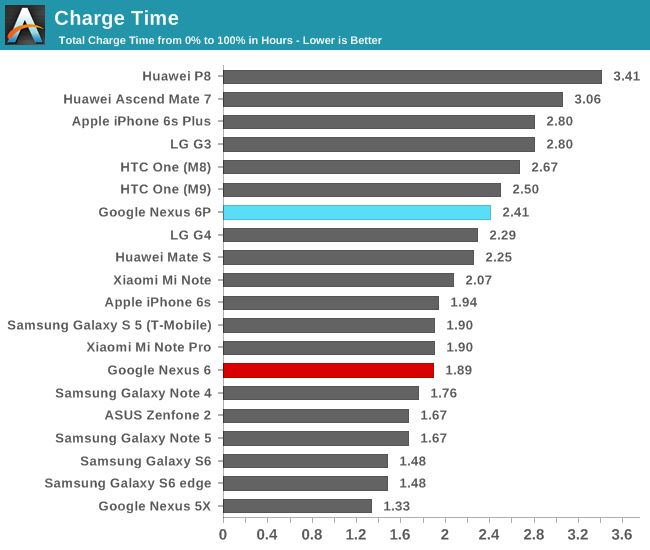
What is worrying is that the battery charge indicator is extremely inaccurate at high charge levels. The device reports 100% much earlier than other devices. In fact there’s still over 2W of power coming into the battery as it reports being fully charged. This goes on for another 40 minutes, representing an actually significant amount of energy representing about 7% of the battery’s true capacity. As such, the Nexus 6P doesn’t receive a good grade in the charge time metric due to its misleading charging indicator behaviour.
Nevertheless, it’s able to charge from 0 to 40% in 30 minutes which is outstandingly fast. 45 to 80% takes about an equal amount of time which means for the large majority of use-cases where you are in desperate need of power the Nexus 6P will be able to serve you well (As long as you have your charger and cable with you).


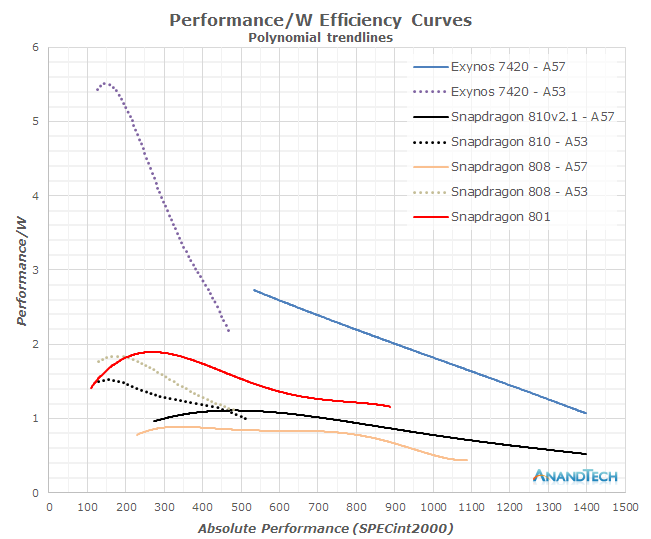
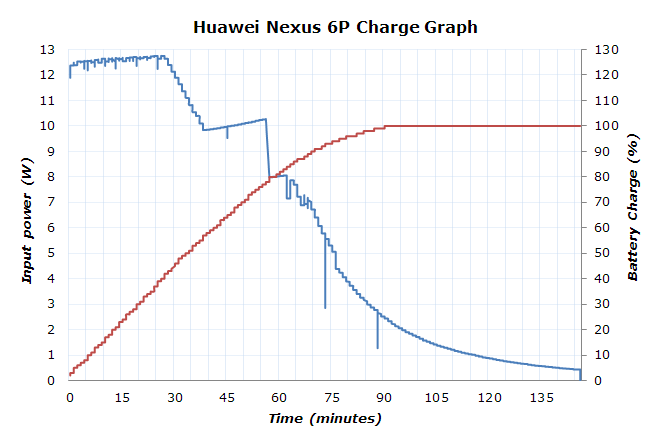








219 Comments
View All Comments
grayson_carr - Thursday, December 17, 2015 - link
*car, not carerstuart - Thursday, December 17, 2015 - link
Then you have a non-standard compliant USB-C to USB-A cable. A USB-C charging device must indicate the maximum charging rate it supports using a resistor across the CC pins (A5 & B5). The values are 10K for 3A, 22K for 1.5A and 56K for legacy (0.5A). (This can be found in the USB specs, which are free to download from usb.org.)The issue is a passive USB-A to USB-C cable can't know what charging rate the device it connects will support, so the spec only allows on value for such adaptors - 56K, which means legacy (0.5A).
Your cable probably claims to support 3A. If it is connected to a cheap charger that is also non-standards compliant, your at risk of causing a fire.
Right now the USB-C market is a mess. I wanted to verify the USB-C to USB Micro A adaptor I purchased had the right resistor, and since the pins on USB-C are about as wide as a bees dick I purchased a USB-C breakout PCB (like this https://www.saikosystems.com/Web/images/Product/ic... ). It had no resistor at all, so I purchased a different brand. It was the same. I am pretty persistent, so I own 15 of them now. Not one is standards compliant.
grayson_carr - Friday, December 18, 2015 - link
I have the USB-A to USB-C cable from the Google Store... and Benson Leung, the Google employee who has been testing them, says it is spec compliant. Having a compliant cable does not mean you can only charge at 0.5A. It just means you can't charge at 3A like you can with a USB-C to USB-C cable.grayson_carr - Friday, December 18, 2015 - link
Also, your view of how USB cables work is too simplistic and wrong. If a USB-A to USB-C cable has a 56K pull-up resistor (as it should), it doesn't just automatically default to the base rate of 0.5A. It will defer to the USB BC 1.2 protocol to negotiate an appropriate current that both the charger and device can handle.SanX - Wednesday, December 16, 2015 - link
One thing bothered me in previous models inluding Nexus 6 was permanent focus "hoping" during video recording when you turn the camera like all cheapo camcorders do. That was present in all modes, the 1080 or 2160. This defect literally trash all your movies specifically visible and annoying in 2160. Must be a second camera module (they are cheap novadays, just a few dollars) which has to do hoping while the main one just do the final focusing if needed.JMC2000 - Wednesday, December 16, 2015 - link
I find the issue with the orientation of the back button a bit funny; personally, I despise having back on the right side of the navbar, and I'm right-handed. I can't stand the location of the back button on my Note 4, yet using on-screen buttons on it drives me insane.Whenever I run Cyanogen/ASOP roms, I always use this navbar layout (left to right):
Menu, Back, Home, Recents, Search
bogda - Thursday, December 17, 2015 - link
I am really dissaponted with direction Nexus devices took. Back in a days when I bought my Nexus 7 it was a very good device for a money. Now Google is dropping all reasons to buy Android vs iOS device. If I want iOS device I will buy one not, Android device with all annoying features of iOS devices and higher resolution display.And price in Europe that is 40% higher than in US is a cherry on the top.
oRAirwolf - Thursday, December 17, 2015 - link
Would you guys be so kind as to provide us with your testing methodology for determining NAND speeds? I know you have used Androbench in the past, but you mentioned that you used some custom settings. What settings are you using? I'd like to be able to compare the performance of some other of my devices that haven't been benched to get an idea how they compare.Thanks for your great review. I hope to see a Pixel C review soon :)
hfm - Thursday, December 17, 2015 - link
You guys seriously need editorial review. I got hung up on poor grammar and sentence structure a couple times in the review.Larry Endomorph - Thursday, December 17, 2015 - link
Agreed. More than "a couple times". Many more. And spelling errors.